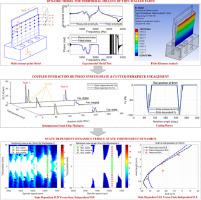International Journal of Mechanical Sciences ( IF 7.3 ) Pub Date : 2021-01-21 , DOI: 10.1016/j.ijmecsci.2021.106294 Jinbo Niu , Jinjie Jia , Ruoqi Wang , Jinting Xu , Yuwen Sun , Dongming Guo

|
Chatter avoidance and error control are the core issues accompanying milling processes of thin-walled parts. Owing to the high flexibility of workpiece, the cutting vibrations can easily reach dozens of micrometers and become comparable to the nominal chip thickness. However, the classic dynamic models usually neglect the influence of system state on regenerative stability and surface location error (SLE), which consequently reduces the prediction accuracy. In this paper, the coupling relationships between cutter-workpiece engagement, time delay and system state are modeled by means of analyzing the true teeth trajectories that are composed of tool rotation, feed movement and cutting vibrations. The resultant dynamic model is a state dependent delay differential equation, which is capable of accounting for the fly-over and multi-regeneration nonlinear phenomena too. Afterwards, an efficient numerical algorithm is proposed to accurately compute the dynamic responses. By contrast to classic time domain simulation techniques, the proposed algorithm uses discrete root finding scheme to determine the state dependent time delay and the state dependent cutter-workpiece engagement, which ensures its high computational efficiency. Based on the proposed dynamic model and numerical algorithm, the stability limits and SLE are finally obtained, and experimentally validated on two thin-walled plates using two variable pitch tools. Theoretical comparison and experimental results reveal that the proposed state dependent dynamic model successfully predicts the milling stability and SLE while the classic model fails. The state dependency of regenerative stability and SLE is further investigated and explained in detail.
中文翻译:

薄壁零件外围铣削中取决于状态的再生稳定性和表面位置误差
避免颤振和错误控制是薄壁零件铣削过程的核心问题。由于工件的高柔韧性,切削振动很容易达到数十微米,可与标称切屑厚度相媲美。但是,经典的动力学模型通常忽略了系统状态对再生稳定性和表面位置误差(SLE)的影响,因此降低了预测精度。在本文中,通过分析由刀具旋转,进给运动和切削振动组成的真实齿轨迹,对刀具-工件啮合,时间延迟和系统状态之间的耦合关系进行建模。最终的动态模型是一个状态相关的延迟微分方程,它也能够解决飞越和多次再生的非线性现象。然后,提出了一种有效的数值算法来准确地计算动态响应。与经典时域仿真技术相比,该算法采用离散根查找方案来确定状态相关的时间延迟和状态相关的刀具-工件啮合,从而确保了其高计算效率。基于所提出的动力学模型和数值算法,最终获得了稳定性极限和SLE,并使用两个可变螺距工具在两个薄壁板上进行了实验验证。理论比较和实验结果表明,所提出的状态相关动力学模型成功地预测了铣削稳定性和SLE,而经典模型则失败了。


























 京公网安备 11010802027423号
京公网安备 11010802027423号